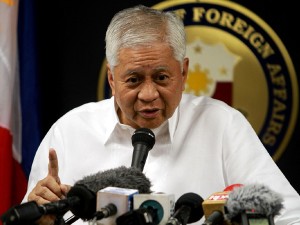China indicates intent to move its ships out of shoal
MANILA, Philippines—China has expressed intention to withdraw its vessels from the lagoon at the disputed Panatag (Scarborough) Shoal in the West Philippine Sea, Foreign Affairs Secretary Albert del Rosario said Friday.
“The Chinese still have vessels in the lagoon and we’re waiting for them to remove those vessels from that area,” Del Rosario told reporters at the Manila Peninsula Hotel in Makati City.
He was speaking at the sidelines of the signing of the agreed minutes of the 2nd Joint Commission on Bilateral Cooperation with visiting Myanmar Foreign Minister U Wunna Maung Lwin.
“That’s precisely what we’re waiting for. We’re waiting for them to meet their commitment to remove their vessels from the lagoon,” he answered when pressed about the assurance that China would honor the commitment it made “a couple of days ago.”
Citing reports from the Philippine Coast Guard, Del Rosario said there are about 20 to 26 fishing boats inside the lagoon as of Thursday.
“According to the Coast Guard, the situation in the area remains the same … stable,” he said, adding that the Philippines no longer has any vessel inside the lagoon.
Del Rosario said he has no information about the Chinese jetfighter that reportedly flew over Panatag Shoal earlier this week.
“It was validated that there was one plane that passed by and my information was that it was our own reconnaissance that did that. I don’t have any information on the fighter jet,” he said.
China has yet to comment on the latest pronouncements of Del Rosario, but China foreign ministry spokesman Liu Weimin said in an article posted on the Chinese government web portal Thursday that Chinese fishing boats are currently doing “normal fishing” in Huangyan Island waters in the South China Sea, and “Chinese government vessels will continue to provide management and services for its fishing ships and fishermen.”
Huangyan Island is China’s name for the shoal, which the Philippines also calls Bajo de Masinloc.
“The general situation tends to ease,” he said, but warned, “China hopes the Philippines will not take moves that will complicate and magnify the situation.”
Liu said China had noted remarks made by President Benigno Aquino at an event held Wednesday to commemorate China-Philippines bilateral ties. He said they included words on easing tensions over competing claims of sovereignty in the South China Sea.
According to Liu, Aquino addressed the importance he attaches to bilateral ties, and China also values these relations.
“China hopes for concerted efforts by the two countries to push forward healthy development of the ties,” Liu said.
Aquino, during his speech on Wednesday, also upheld Philippine sovereignty and territorial integrity by noting Philippine and international laws.
Liu said China has taken note of Aquino’s stance, while pointing out that Philippine authorities had confirmed on many occasions that Huangyan Island is not within Philippine territory under the nation’s laws.
Liu said the UN Convention on the Law of the Sea does not constitute international law defining territorial claims.
“Therefore, it is undoubted that China owns sovereignty over Huangyan Island,” Liu reiterated.
Meanwhile, Del Rosario said he and Myanmar foreign minister discussed the ongoing standoff at the disputed shoal.
“We discussed it. Essentially we’re saying that we’re out to diffuse the situation. We want to break the impasse and we’re in consultations directly with China to do this,” he said.
The foreign affairs secretary did not directly say if the Philippines sought the help of Myanmar on the issue but he said the latter has committed to review the basic fundamental elements that the Philippines submitted for the drafting of the Code of Conduct for the South China Sea “for possible support.”
“We’re trying to undertake this on a bilateral consultation directly with China. We just explained (to Myanmar officials) the situation just for their information. Of course, any form of support or assistance is welcome. We could benefit from the support of other countries,” Del Rosario said.
“[Myanmar officials] said they are for settling the issue through peaceful means, and that they are for bilateral consultations,” he continued.
Del Rosario expressed hope that the Association of Southeast Asian Nations will be able to help out in terms of finalization of the Code of Conduct for South China Sea.
“We said that we are interested in moving forward the basic elements that we introduced for that COC and we hope that Myanmar will support it. We’re trying our best to move it forward and we’re seeking the assistance and support of other members of Asean in order to be able accomplish this,” he added, noting that the Philippine elements “are fairly straightforward.”
During the Asean Summit last April in Cambodia, the Philippines asked Asean to take the lead in resolving the West Philippine Sea issue, and to bring the Spratlys claimants together towards “a rules-based, multilateral and peaceful resolution of the issue.”
The Philippines emphasized at the summit the centrality of Asean with respect to the drafting of the Code of Conduct for the South China Sea incorporating key elements to include a dispute settlement mechanism and an administrative structure to implement them.
“We don’t put anything on the table that is not negotiable,” Del Roario said when asked if the elements introduced by the Philippines are non-negotiable. “We think that it’s a process of accommodation and compromise. We think that a Code of Conduct should be substantive, it should be crafted in a way that the disputes are moved forward for settlement.”
Aside from the Philippines, Asean also groups Singapore, Indonesia, Malaysia, Thailand, Vietnam, Myanmar (formerly Burma), Laos, Cambodia and Brunei Darussalam.
Four Asean members–the Philippines, Vietnam, Malaysia and Brunei–are among the Spratlys claimants, along with China and Taiwan.
For comprehensive coverage, in-depth analysis, visit our special page for West Philippine Sea updates. Stay informed with articles, videos, and expert opinions.
